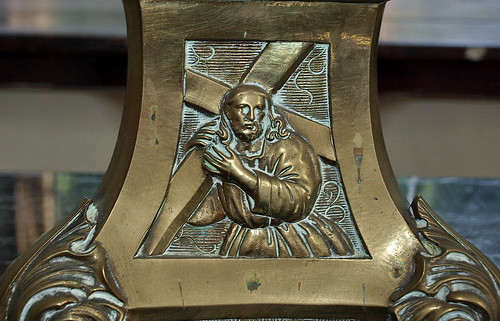The most obvious point of interest is the square tower which has characteristics to suggest a 11th or 12th century date. Whilst early square towers are not unusual where good building stone is available, they are uncommon in Norfolk, not least when primarily constructed with flint. This tower has large blocks of limestone at the base forming long and short work, but much of the original tower has flint quoins which is very rare and shows faith in the mortar used. There are only six churches in Norfolk with square towers compared to 123 surviving round towers. In fact, Hethel is situated in a part of Norfolk where there is the greatest concentration of round towers, so the form of this tower is most unusual. [hbsmrgateway2.esdm.co.uk/norfolk/DataFiles/Docs/AssocDoc110.pdf]
ALL SAINTS. Unbuttressed W tower, perhaps Norman. Later two-stepped battlements. Minimum N arcade of three bays with octagonal piers and double-chamfered arches. There was a N chapel as well, but that was rebuilt as, or converted into, the Branthwaite family chapel or MAUSOLEUM. It has a brick N facade of rather Vanbrughian character, with rusticated quoins, blank arched windows filled in with blue brick, and identically filled-in segment-headed windows in the heavy parapet above. Inside three blank tablets. So the date is unrecorded. It seems to be c.1730. In fact the first interment was in I740. The Gothick doorway from the E, dated 1819, is clearly later. The S porch of the church is Perp, but has a later stepped gable. The nave and N aisle windows are of an elementary C18 or C17 type. - PLATE. Chalice, originally secular, as it has a workman’s double-hammer. The hall-mark is London. the date probably 1559.* - MONUMENT. Myles Branthwaite d. 1612 and wife. Alabaster. He rests on his elbow behind and above her. Columns l. and r. carrying obelisks. Coffered arch and inscription plate framed by fine strapwork and fruit.
* The rector of Bracon Ash and Hethel kindly informed me that the chalice is now believed to have been made in 1532 at Ghent by Jan van Hanweghen.
HETHEL. It lies on the road to nowhere, with a moated rectory, a church prettily set among fields down little-used lanes, and a hawthorn tree growing close by which must be almost unique. Gnarled, twisted, and bowed, the Hethel Thorn has a trunk like twisted cables and arms like an octopus, and is still a very fine tree, though it is believed in the village that its first blossoms perfumed the air 700 years ago. Still it wears them every spring, and in winter its propped-up branches bear clumps of mistletoe.
The odd little church with an embattled tower is a medley of centuries not too happily blended, especially on the workaday north side. Much of it is 14th century, but the porch, which shelters a holy water stoup, is 15th. The chief interest of the church is in the pompous monument of Myles Branthwaite, a lord of the manor of Shakespeare’s day, “freed from the dust and cobwebs of this vaile." Myles and his wife lie one above the other, he a ponderous figure reclining stiffly in a fur-lined cloak, she in a gown with many bows and hair like sunset rays. Below them kneel their three children.
The odd little church with an embattled tower is a medley of centuries not too happily blended, especially on the workaday north side. Much of it is 14th century, but the porch, which shelters a holy water stoup, is 15th. The chief interest of the church is in the pompous monument of Myles Branthwaite, a lord of the manor of Shakespeare’s day, “freed from the dust and cobwebs of this vaile." Myles and his wife lie one above the other, he a ponderous figure reclining stiffly in a fur-lined cloak, she in a gown with many bows and hair like sunset rays. Below them kneel their three children.



No comments:
Post a Comment